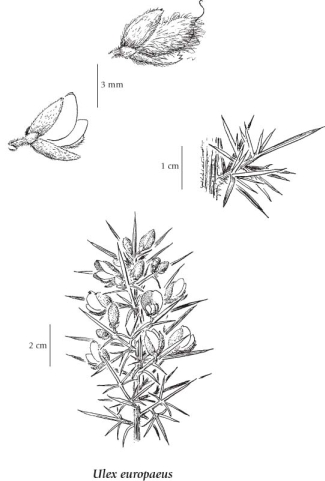Ulex europaeus L.
gorse (common gorse)
Fabaceae (Pea family)
Introduction to Vascular Plants
gorse (common gorse)
Fabaceae (Pea family)
Introduction to Vascular Plants
Introduction
Common gorse is an introduced European species of disturbed sites, grasslands, forest edges and coastal bluffs that is now found in North America along the Pacific Coast, and in several New England states (US--CA, HI, MA, NY, OR, PA, VA, WA, WV; CAN--BC) (USDA 2010). In British Columbia, it is found in the southwest corner of the province with some records from the Queen Charlotte Islands. It is a perennial yellow-flowered shrub with spine-tipped branches that ranges from 1-3 m tall. Branches are noticeably 5-angled. Fruits are pods. Seed have a hard, water-impervious coat that can delay germination (Global Invasive Species Database 2010). Infestations of this species can result in impoverished soil (Global Invasive Species Database 2010).
References: Global Invasive Species Database. 2010. Ulex europeus. Invasive Species Specialist Group (ISSG) of the IUCN Species Survival Commission. Available Online. USDA. 2010. Plant profile for Ulex europeus. United States Department of Agriculture Plants Database. Available Online. |
Species Information
General:
Medium to tall shrub, 1-3 m tall; stems erect, densely branched, the branches greenish, prominently 5-angled, sparsely black-hairy, tipped with spines.
Leaves:
Alternate, deciduous, leaflets 3 on young plants, reduced to stiff scales or spines pressed close to the branches in mature plants, the spines rigid, grooved, branched, 1.5-2.5 cm long.
Flowers:
Inflorescence of single pea-like flowers borne along the lateral branches on velvety 3- to 5-mm long stalks; corollas yellow, 15-20 mm long, the wings slightly longer than the keel, which is hairy along the lower margin; calyces yellow, membranous, 10-15 mm long, spreading-hairy, egg-shaped, 2-lobed, the lower lip minutely 3-toothed, the upper minutely 2-toothed.
Fruits:
Pods, short-oblong, flattened, black, grey- or brown-hairy, 1.5-2 cm long; seeds several, ejected by explosive splitting of the pod.
Illustration

If more than one illustration is available for a species (e.g., separate illustrations were provided for two subspecies) then links to the separate images will be provided below. Note that individual subspecies or varietal illustrations are not always available.
Illustration Source: The Illustrated Flora of British Columbia